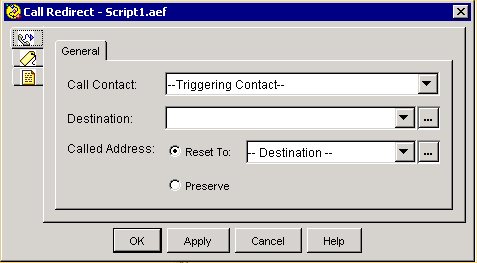Call Redirect Step
Use the Call Redirect step to redirect a call to another extension.
Note | The Call Redirect step creates a new call which can result in double counting of an inbound call on real-time reports. Use the Select Resource Step if you do not want this to occur. |

The Call Redirect step is often used in Interactive Voice Response (IVR) applications to transfer a call once a desired extension has been specified.
The Call Redirect step produces four output branches:
-
Successful—The call is ringing at the specified extension.
-
Busy—The specified extension is busy, and the call cannot be transferred.
-
Invalid—The specified extension does not exist.
-
Unsuccessful—The redirect step fails internally.
Place script steps after each of the different branches provided by this step to handle the possible outcomes of a redirected call.
Note |
|
The following table describes the properties of the Call Redirect customizer window.
|
Properties / Buttons |
Description |
|---|---|
|
Call Contact |
Contact that you want to redirect. The default is Triggering Contact, unless another contact is defined. |
|
Destination |
Variable that holds the extension where the call is to be redirected. (See for supported extensions.) |
|
Called Address |
Select one of the following options:
If you select the Reset To option, you can select a value from the drop-down list. This value is reflected in the origCalledAddr column in Contact Call Detail Record (CCDR) report. If you select the Preserve option, the null value is reflected in the origCalledAddr column in CCDR report. |
The following table describes the extensions supported by the Call Redirect step.
|
Extension |
Description |
||
|---|---|---|---|
|
Extensions starting with “#” or “*” |
Extensions that trigger a network take-back and transfer where the specified string is outpulsed as is. The redirect is successful if a hang-up event occurs within a maximum of 5 seconds.
|
||
|
Extensions ending with “.wav” |
Extensions that trigger a network announcement type of redirect in which the system simulates a ring-back tone, then plays back the specified .wav file 4 times, and finally simulates a fastbusy tone. The redirect is successful if at any time the caller hangs up or the end of the fastbusy tone is reached, at which point the call is disconnected. |
||
|
Extensions equal to “PROBLEMS” |
Extensions that trigger a network announcement type of redirect with a system problem announcement. The redirect is successful if at any time the caller hangs up or the end of the audio is reached. The call will be reported as disconnected, not redirected. |
||
|
Extensions equal to “BUSY”, “RNA”1, “FASTBUSY” or “DIALTONE” |
The specified audio treatment is generated before the call is disconnected. The redirect is successful if at any time the caller hangs up or the end of the audio is reached. The call will be reported as disconnected, not redirected. |